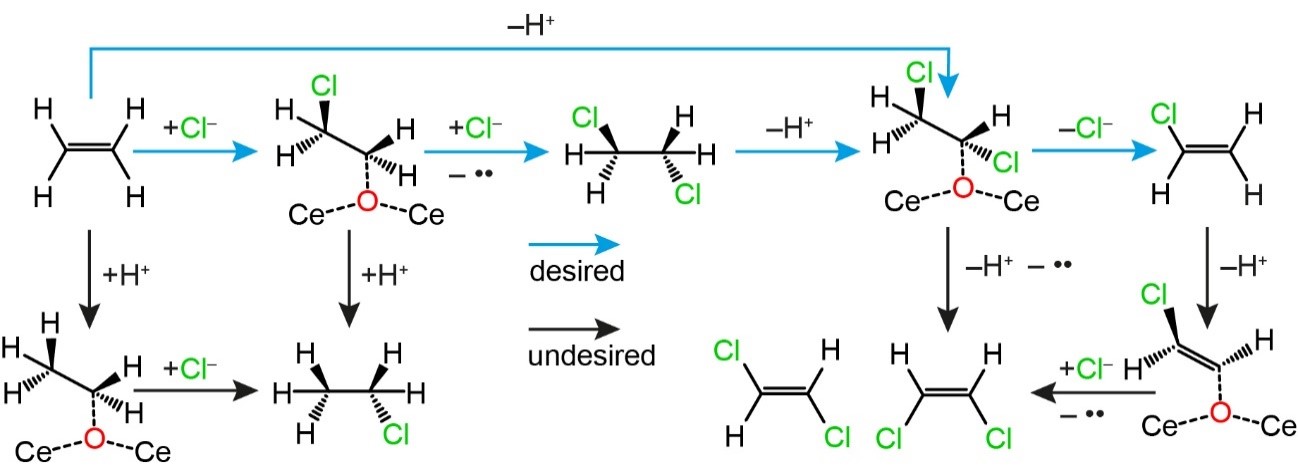Mechanism of ethylene oxychlorination on RuO2 and CeO2
The manufacture of polyvinyl chloride (PVC) relies on the production of vinyl chloride (VCM) via a two-step process comprising ethylene oxychlorination to ethylene dichloride (EDC) on intrinsically unstable cupric chloride catalysts and a subsequent energy-intensive thermal cracking. Recently, we demonstrated that certain oxides or oxychlorides (e.g., CeO2) could serve as stable bifunctional catalysts, performing the two reactions in a single step and attaining VCM in up to 25% yield.1,2 To gain deeper understanding of the oxychlorination mechanism, we investigate the complex reaction network by density functional theory (DFT), kinetic testing, and advanced characterization. In a first step, decoupling the complexity of the reaction network and CeO2, DFT calculations were conducted on the simpler RuO2, revealing the thermodynamic and kinetic control of oxidation and chlorination processes, respectively. Furthermore, the degree of chlorine coverage emerged as a key factor governing the selectivity, as it confines or destabilizes intermediates and determines the ability of the surface to abstract H atoms. This enabled simplification of the reaction network (Figure 1) for its investigation on a CeO2 {111} surface in a second step. Preliminary results suggest that an ideal CeO2 surface is unable to catalyze oxychlorination as the barriers for all important chlorination and dehydrogenation steps are 1.7 eV and higher. The introduction of defects, i.e., by replacing a surface O by a Cl atom which can react and form a vacancy, leads to at least 0.5 eV decreased barriers for most chlorination reactions. Inspired by these results, we are developing a microkinetic model and experimentally assessing the impact of vacancies formed by controlled reduction of CeO2 on its oxychlorination performance. Previously, acidity was shown to be strongly related to VCM selectivity,1,2 but the exact nature of the sites remained unknown. DFT indicates that ceria acts as a Brønsted and Lewis acid/base pair, encouraging the investigation of the acid sites by solid-state NMR spectroscopy after adsorption of the probe molecule trimethylphospine. The combination of these results will reveal the detailed mechanism of ethylene oxychlorination on oxide-based catalysts and guide the development of more selective VCM catalysts.

Figure 1 Simplified reaction network of ethylene oxychlorination, excluding oxidation steps which can start at any node.
[1] M. Scharfe, P. A. Lira-Parada, V. Paunović, M. Moser, A. P. Amrute, J. Pérez-Ramírez, Angew. Chem. Int. Ed. 2016, 55, 3068.
[2] M. Scharfe, P.A. Lira-Parada, A. P. Amrute, S. Mitchell, J. Pérez-Ramírez, J. Catal. 2016, 344, 524.